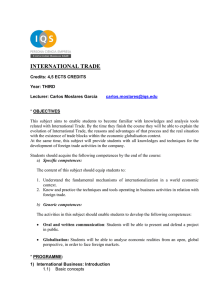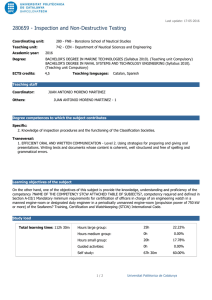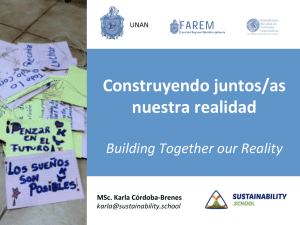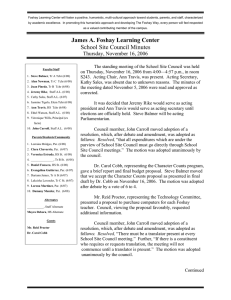The Youthpass process and Learning to Learn. Some ideas for
Anuncio
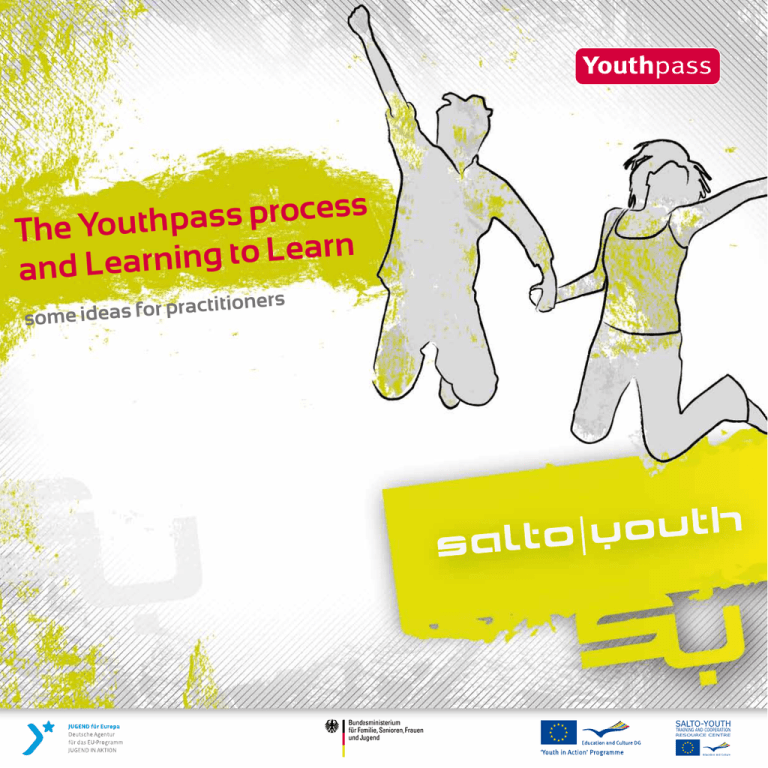
s s e c o r p s s a p h The Yout rn a e L o t g n i n r a and Le p some ideas for ractitioners SALTO-YOUTH TRAINING AND COOPERATION RESOURCE CENTRE Education and Culture Introduction Youthpass has been applicable for Youth Exchanges, European Voluntary Service (EVS) and Training Courses in the Youth in Action Programme since the beginning of 2007; the Key Competences for Lifelong Learning were adopted at the end of 2006 and Youthpass is the first instance of a European educational programme putting them into operation. We have some experience to reflect upon and possibly some conclusions to make for future practice. This paper is intended to help fur ther debates around the competence ‘learning to learn’ and its application in the Youthpass process. It is par ticularly intended for trainers and other practitioners in the Youth in Action Programme who are implementing Youthpass. Sources and suggested fur ther reading come at the end. All comments welcomed! 2 Youthpass – the sea change! The gradual introduction of Youthpass into the Youth in Action Programme is a huge sea change in European youth work. Why to make such a huge claim? What we have come to call ‘the Youthpass process’ now obliges all organisers of activities under the Programme to consider the learning potential of those activities from the star t. Cer tainly, many practitioners in the past would be doing so – now everyone should! Each par ticipant has to be informed about the possibility of getting a Youthpass Certificate and has to choose if they want to go through a Youthpass process, or not… And then they need to get into all this stuff about ‘Key Competences’ and that includes ‘learning to learn’… 3 Learning to learn – where does that fit in? If we are to give more impor tance to learning within the Youth in Action Programme, this means we need to know something about how people learn, how to facilitate that process and to recognise learning when it happens. And it is here that the concepts and practice of learning to learn come into play as they can help us to explore some of the crucial questions. How to make the Youthpass process an attractive one which finds rightful place within an activity? How are learners to be suppor ted in their learning process? How are learners to gain control of their own learning? Crucical questions How to star t making sense of the framework provided by the Key Competences for LLL? How to know what has been learned and how to describe it? Who are the suppor ters and what skills do they need? Learning to learn does not benefit from having an all encompassing definition which is agreed everywhere. For the moment we can content ourselves with the descriptions offered by the European Commission and the SALTO T&C RC that it is ‘the ability to organise our own learning’ and includes elements such as - ‘effective management of time and information’ - raising awareness of our learning needs, and - how to achieve them. 4 Such skills and awareness development find a place in our wider lives as emphasised by many writers, such as Knud Illeris who states ‘In a society where more and more learning is an unavoidable condition of life, one must learn to learn, i.e. learn to manage and economise one’s own learning’. Learning to learn engages other competences as we can see and for that reason it is often referred to as a ‘meta competence’ – another way of showing that it has an impor tance and we need to be paying more attention to it! 5 – Learning to learn where does that fit in? This section takes some of the questions and some of the tentative conclusions I have arrived at together with colleagues in combining learning to learn within the Youthpass process. As is always the case in situations where rigorous research is looked upon as a luxury, I have to rely on anecdotal evidence. We can only hope that papers like these might have a motivational effect on decision-makers to provide some much-needed resources to investigate closer! How to attract people to be involved in the Youthpass process? Some simple things have been found to work: Your friends have done it – ask them about it! You can learn something and show off about it! You get closer to other people talking about what you have done and comparing impressions! It is your free choice; nobody is forcing you to do it! You can use the Youthpass Cer tificate! Very noticeable in the observation of our practice in the recent past has been a growing tendency amongst facilitators and trainers to say ‘we have to learn to let it go’ – by this we mean that we have to integrate into the way we work the fact that it REALLY is the learner who makes the decisions about what and how to learn. At some point it is the learner who decides which direction to take and they must go their own way. This also means getting away from being what I call ‘super trainers’ who have to make the ‘real’ conclusions at the end of each session for their par ticipants! We are really at the beginning of realising the many consequences of operationalising a learning to learn philosophy. It is tough as a trainer, a facilitator to know when we reach the limits and we need maybe some more discussion, reflection, research and thought about designing courses and possible attitude change. What do you think about this? 6 In putting Youthpass into practice, one of the challenges is in working with par ticipants about what they want to learn within a Youth Exchange, European Voluntary Service or in a Training Course. Many of them come out of formal educational systems which do not prepare them to define such things – the school has told them what it was impor tant to learn. If we star t bringing in what sounds like strict educational terminology, then it seems that many par ticipants find that fairly frightening (or, at least, not exactly friendly or motivating!). So it is suggested to replace terms like ‘setting learning objectives’ with ‘what are you interested to learn?’ or “what are your learning interests?’. How to know when you have learnt something is quite a complex subject! Looking back at what has happened and experiencing ‘aha moments’ in that process can help identify learning. A really useful avenue to explore fur ther would seem to be that of reflective writing (and integrating imagery into that process) to help par ticipants to fix what they are learning as they go along. Especially useful this, as par ticipants can use pictures, collages and other forms of expression which do not all have to rely on words. A simple little notebook, used cleverly, can be an incredibly powerful tool for learning. It is also possible to experiment with the use of such notebooks by making us of what some have called ‘Random Diary Moments’ – drawing inspiration from the work of Mihály Csíkszentmihály – to get par ticipants to just stop whatever they were doing and write down what they were really doing, their feelings and any learning that was taking place at that moment. Sharing such moments can help a great deal in helping to recognise when and what is being learnt! 7 Transferring the learning into the Key Competences can be helped by asking people to break down what they already know and do into skills, knowledge and attitudes – a recent example being the answer to the question ‘What do we bring to our youth work?’. Then to take their results and work together on assigning those factors to the Key Competences. It seems to be concrete enough for people to think about it and apply their findings without the fear which often surges to the forefront when we introduce this framework! And transferring the learning back into wider situations in life is crucial, as James points out: In a rapidly developing world in which the creation of knowledge increases exponentially, the crucial resource in ‘knowledge economies’ is the ability of people to respond flexibly and creatively to demands for new knowledge, skills and dispositions in continuously changing social and economic contexts. […] In this context, development of a capability to learn new things, throughout life, becomes essential (James et al. 2007: 3-4). This paper is very clearly a work-in-progress and needs to be updated regularly with help from colleagues – so please send your reactions, thoughts and suggestions! Good luck for your own process! 8 References and suggestions for further reading! Bergstein, R, Kloosterman P, et al (2009): Youthpass Guide, SALTO T&C RC Csíkszentmihályi, Mihály (1997): Finding flow: the psychology of engagement with everyday life Giordan, A, Saltet, J (2007): Apprendre à apprendre, Librio, Paris Illeris, Knud (2007): How we learn. Learning and non-learning in school and beyond. Routledge, London James, Mary et al. (2007): Improving learning how to learn, Routledge, London Moon, J.A. (2004): A Handbook of Reflective and Experiential Learning – Theory and Practice, Routledge Falmer, London Schroeder, K. (2010): Youthpass for all!, SALTO Inclusion & SALTO T&C RC, Brussels, Bonn Unique Network’s Grundtvig project on Learning to Learn: http://www.learning2learn.eu/ (Accessed 12 February 2010) VanderStoep S.W., Pintrich P.R.(2008): Learning to Learn: the Skill and Will of College Success, Pearson Prentice Hall, Ohio 9 Author : Mark Taylor, Strasbourg, June 2010, [email protected] Edited by SALTO Training & Cooperation Resource Centre, Bonn/Germany, contact person: Rita Bergstein ([email protected]) This publication is funded by:

